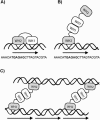Role of pi dimers in coupling ("handcuffing") of plasmid R6K's gamma ori iterons
- PMID: 15901701
- PMCID: PMC1112066
- DOI: 10.1128/JB.187.11.3779-3785.2005
Role of pi dimers in coupling ("handcuffing") of plasmid R6K's gamma ori iterons
Abstract
One proposed mechanism of replication inhibition in iteron-containing plasmids (ICPs) is "handcuffing," in which the coupling of origins via iteron-bound replication initiator (Rep) protein turns off origin function. In minimal R6K replicons, copy number control requires the interaction of plasmid-encoded pi protein with the seven 22-bp iterons of the gamma origin of replication. Like other related Rep proteins, pi exists as both monomers and dimers. However, the ability of pi dimers to bind iterons distinguishes R6K from most other ICPs, where only monomers have been observed to bind iterons. Here, we describe experiments to determine if monomers or dimers of pi protein are involved in the formation of handcuffed complexes. Standard ligation enhancement assays were done using pi variants with different propensities to bind iterons as monomers or dimers. Consistent with observations from several ICPs, a hyperreplicative variant (pi.P106L(wedge)F107S) exhibits deficiencies in handcuffing. Additionally, a novel dimer-biased variant of pi protein (pi.M36A(wedge)M38A), which lacks initiator function, handcuffs iteron-containing DNA more efficiently than does wild-type pi. The data suggest that pi dimers mediate handcuffing, supporting our previously proposed model of handcuffing in the gamma ori system. Thus, dimers of pi appear to possess three distinct inhibitory functions with respect to R6K replication: transcriptional autorepression of pi expression, in cis competition (for origin binding) with monomeric activator pi, and handcuffing-mediated inhibition of replication in trans.
Figures





Similar articles
-
Origin pairing ('handcuffing') and unpairing in the control of P1 plasmid replication.Mol Microbiol. 2004 Nov;54(3):836-49. doi: 10.1111/j.1365-2958.2004.04322.x. Mol Microbiol. 2004. PMID: 15491371
-
Investigations of pi initiator protein-mediated interaction between replication origins alpha and gamma of the plasmid R6K.J Biol Chem. 2010 Feb 19;285(8):5695-704. doi: 10.1074/jbc.M109.067439. Epub 2009 Dec 22. J Biol Chem. 2010. PMID: 20029091 Free PMC article.
-
Mechanism of origin activation by monomers of R6K-encoded pi protein.J Mol Biol. 2007 May 11;368(4):928-38. doi: 10.1016/j.jmb.2007.02.074. Epub 2007 Mar 2. J Mol Biol. 2007. PMID: 17383678 Free PMC article.
-
Regulatory implications of protein assemblies at the gamma origin of plasmid R6K - a review.Gene. 1998 Nov 26;223(1-2):195-204. doi: 10.1016/s0378-1119(98)00367-9. Gene. 1998. PMID: 9858731 Review.
-
Control of plasmid DNA replication by iterons: no longer paradoxical.Mol Microbiol. 2000 Aug;37(3):467-76. doi: 10.1046/j.1365-2958.2000.01986.x. Mol Microbiol. 2000. PMID: 10931340 Review.
Cited by
-
Functional amyloids as inhibitors of plasmid DNA replication.Sci Rep. 2016 May 5;6:25425. doi: 10.1038/srep25425. Sci Rep. 2016. PMID: 27147472 Free PMC article.
-
Microevolution of CG23-I Hypervirulent Klebsiella pneumoniae during Recurrent Infections in a Single Patient.Microbiol Spectr. 2022 Oct 26;10(5):e0207722. doi: 10.1128/spectrum.02077-22. Epub 2022 Sep 21. Microbiol Spectr. 2022. PMID: 36129301 Free PMC article.
-
Replication and conjugative mobilization of broad host-range IncQ plasmids.Plasmid. 2009 Sep;62(2):57-70. doi: 10.1016/j.plasmid.2009.05.001. Epub 2009 May 22. Plasmid. 2009. PMID: 19465049 Free PMC article. Review.
-
Plasmid R6K replication control.Plasmid. 2013 May;69(3):231-42. doi: 10.1016/j.plasmid.2013.02.003. Epub 2013 Mar 5. Plasmid. 2013. PMID: 23474464 Free PMC article. Review.
-
Conjugal transfer of plasmid R6K gamma ori minireplicon derivatives from Escherichia coli to various genera of pathogenic bacteria.Curr Microbiol. 2007 Dec;55(6):549-53. doi: 10.1007/s00284-007-9032-5. Epub 2007 Oct 2. Curr Microbiol. 2007. PMID: 17909888
References
-
- Abhyankar, M. M., J. M. Reddy, R. Sharma, E. Bullesbach, and D. Bastia. 2004. Biochemical investigations of control of replication initiation of plasmid R6K. J. Biol. Chem. 279:6711-6719. - PubMed
-
- Chattoraj, D. K., and T. D. Schneider. 1997. Replication control of plasmid P1 and its host chromosome: the common ground. Prog. Nucleic Acid Res. Mol. Biol. 57:145-186. - PubMed
-
- Das, N., and D. K. Chattoraj. 2004. Origin pairing (‘handcuffing’) and unpairing in the control of P1 plasmid replication. Mol. Microbiol. 54:836-849. - PubMed
Publication types
MeSH terms
Substances
Grants and funding
LinkOut - more resources
Full Text Sources
Research Materials
Miscellaneous

